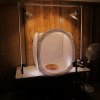Instead of using an auto exposure, switch to aperture priority exposure (Av) and set the ISO to its lowest value (probably either 80 or 100). Also, set the aperture to a stopped down value like f/11 or even f/16. Zoom the lens to a long value and then back the camera and tripod away from the light tent about five or six feet. Since I am not familiar with your particular camera, you would need to experiment around with this. You could even use manual exposure to get even more options in getting the exposure the way that you would like to see it. One thing for sure -- as long as you leave the camera on auto, things are not going to change a great deal. I know that you think that this is getting too technical, but I assure you that this is just barely breaking out of the basic snapshot mode.
I'm still experimenting with this, Bill......
Tried the AV setting and it looks like F8 is the highest setting possible. Custom white balance is set using shortcut button and a white piece of paper......don't know if this is working right, or not, but I think so. On AV, shutter speed is automatic. Will probably have to use manual, because ISO is so high.........
Anyway, so far, not so good. I posted some pics to my AAW album today, and they are still on AUTO setting. Custom White Balance does not work on Auto, but I'm managing to get some clear shots otherwise, with camera close in......better than I've ever gotten before, but they are really big photos......don't see how to change that. The color on these pics doesn't look as nice as without the tent, but the hot spots are greatly reduced. If the Custom White Balance worked in the AUTO mode, I think I could come up with something that looks good.......
I'm going over the manual, but so far, much of it doesn't make much sense to me.......I'm such a novice with cameras, that it's like trying to read it in another language!
It looks like the manual setting will be the way to go, but so far I'm not coming up with anything remotely acceptable.
I've added some clip on incandescent lights, so more light is available.
Will work on this some more...........really frustrating at this point. It's important to me, so somehow I'll muddle through and get results. Someone who knows what they are doing with this S95 camera, could probably show me what to do in a few minutes..........
Thanks for trying to help......

ooc

